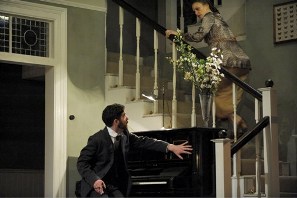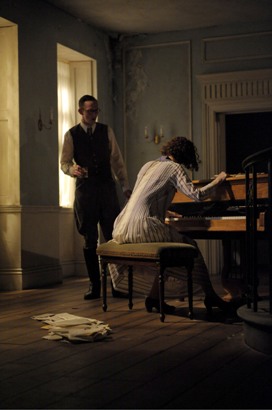Can Thomas Heywood's prosy Jacobean drama of country folk hunting, card playing, screwing around, sliding aristocratically into debt and harrowing one another to death translate successfully to the aftermath of the First World War? Only, perhaps, as edgy semi-farce, towards which Katie Mitchell's nervy, twilit production sometimes veers, not often intentionally. Acting to make you half believe in impossible characters might have saved it. But here you spend less time focusing on the poor puppets who flap around Mitchell's claustrophobic world than looking at the handsome, haunting set.
That's the dominant presence, as designed by Lizzie Clachan and Vicki Mortimer with the kind of atmospheric chiaroscuro from lighting man Jon Clark we've come to expect in a Mitchell dream-vision. Heywood's surprising counterpoint is established immediately by the crumbling Edwardiana of the Mountfords' threatened ancestral home on the left and the Arts and Crafts tastefulness of the Frankford manor to the right, clearly the home of a man who expects things to run smoothly.
Of course it's the Mountford saga which rapidly unravels as the consequences of Sir Charles's ire out hunting lead to imprisonment and the decline of the family fortunes, while John Frankford's discovery of his wife's all too rapid infidelity takes much longer. Heywood gives no clue how time hurtles on past jail spells and infant births, and the first of Mitchell's two masterstrokes is to provide a host of fast-forward filmic interludes set to creepy toccatas by composer Paul Clark. The instrument on which they're heard is crucial: the besieged women of the two households find their only outlet on the piano - Anne Frankford on a bourgeois upright, Susan Mountford on the old family grand.
 What kills the two establishments, however, is that each has a bad actor to bring it down quicker than playwright or director would have wished. And this is a tragedy in a play which has attracted great artists extending back to Ralph Richardson and - in John Dexter's 1971 National Theatre production - Joan Plowright, Derek Jacobi and Anthony Hopkins (would that I'd been old enough to have seen that one). Leo Bill as Sir Charles doesn't have an easy task: he's seen in a permanent state of jittery hysteria which would test the technique of a much more accomplished performer. You don't want to watch; you don't want to listen. Liz White's Anne (pictured above ascending the stairs away from Paul Ready as her husband) begins prettily, but is soon gabbling her lines, and you know it's not going to be a moving spectacle when she screams blue murder once caught in flagrante.
What kills the two establishments, however, is that each has a bad actor to bring it down quicker than playwright or director would have wished. And this is a tragedy in a play which has attracted great artists extending back to Ralph Richardson and - in John Dexter's 1971 National Theatre production - Joan Plowright, Derek Jacobi and Anthony Hopkins (would that I'd been old enough to have seen that one). Leo Bill as Sir Charles doesn't have an easy task: he's seen in a permanent state of jittery hysteria which would test the technique of a much more accomplished performer. You don't want to watch; you don't want to listen. Liz White's Anne (pictured above ascending the stairs away from Paul Ready as her husband) begins prettily, but is soon gabbling her lines, and you know it's not going to be a moving spectacle when she screams blue murder once caught in flagrante.
That the seduction is totally implausible is down to Heywood, who establishes it in 50 cliché-ridden lines (Shakespearean poetry was never going to flourish in this environment, which finds the playwright much happier with his meat-and-potatoes conceits about music-making and a card game as a metaphor for cheating in life). But it doesn't help that Sebastian Armesto's Wendoll is a cad who squeaks rather than oils his way into the lady's bed. Ready as the wronged husband exudes confidence, but this actor buckles when his character is driven to near-murderous madness. I won't be looking forward to his Leontes any time soon.
 The best, in a play which here gives no one the chance to stand out from the crowd and a staging which is Mitchell-typical in having the actors blocked or speaking some of their lines inaudibly upstage, comes from the dignified Susan of Sandy McDade, seen in a number of atmospheric settings (pictured left with Bill). Close behind are Nick Fletcher's low-key shading as the far from bounderish Sir Francis Acton, who seems to fall in love with Susan's grace and poise, and Gawn Grainger as the outspoken servant who spills the beans in the Frankford household.
The best, in a play which here gives no one the chance to stand out from the crowd and a staging which is Mitchell-typical in having the actors blocked or speaking some of their lines inaudibly upstage, comes from the dignified Susan of Sandy McDade, seen in a number of atmospheric settings (pictured left with Bill). Close behind are Nick Fletcher's low-key shading as the far from bounderish Sir Francis Acton, who seems to fall in love with Susan's grace and poise, and Gawn Grainger as the outspoken servant who spills the beans in the Frankford household.
By then we've even got a little tired of the harum-scarum intermezzi, with overindulgence in Mitchell's trademark intrusions of servants/functionaries - we saw a lot of that in the English National Opera Idomeneo - and banging doors. We even get the ubiquitous Mitchell suitcases as Frankford, in a gesture which can by no stretch of the imagination be called kindness, banishes his wife to a house some leagues hence - though the context does call for them here.
There's one final coup as the hydraulics conjure before our eyes a bleak scene to obscure the domesticity previously under siege: Anne dying in hospital (unconvincingly, again, in White's stilted delivery) with the onlookers ranged frieze-like in what looks to me like an homage to that marvellous early-20th-century artist Frederick Cayley Robinson. Intentional or not, it's a painterly piece of direction. And as if we hadn't already got the message that in Mitchell's opinion the two leading ladies are used as chattels, it's Susan who gets what is originally Frankford's last line: "Here lies she whom her husband's kindness killed." We don't much care, but the time does bend curiously throughout the uninterrupted course of the drama. If only two of the key performances gave it more of a helping hand.















Add comment